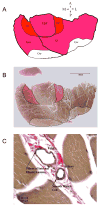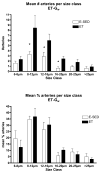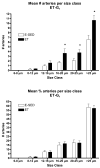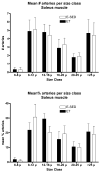Exercise training produces nonuniform increases in arteriolar density of rat soleus and gastrocnemius muscle
- PMID: 16627360
- PMCID: PMC2646594
- DOI: 10.1080/10739680600556829
Exercise training produces nonuniform increases in arteriolar density of rat soleus and gastrocnemius muscle
Abstract
Objective: Exercise training has been shown to increase regional blood flow capacity to muscle tissue containing fibers that experience increased activity during exercise. The purpose of this study was to test the hypothesis that the increased blood flow capacity is partially the result of increases in arteriolar density (number of arterioles/mm2 of tissue), specifically in skeletal muscle tissue, with the largest relative increase in muscle fiber activity during training bouts.
Methods: This hypothesis was tested by comparing and contrasting the effects of endurance exercise training (ET) and interval sprint training (IST) on arteriolar density in soleus muscle (S) red (Gr) and white (Gw) portions of gastrocnemius muscle of male Sprague Dawley rats. ET rats completed 10 weeks of treadmill training 30 m/min, 15% grade, 60 min/day, 5 days/week, while IST rats completed 10 weeks of IST consisting of six 2.5-min exercise bouts, with 4.5-min rest between bouts (60 m/min, 15% incline), 5 days/week. The hypothesis would be supported if ET increased arteriolar density in S and Gr and if IST increased arteriolar density in Gw.
Results: ET increased arteriolar density above values of sedentary rats (SED) in both the Gw (ET = 0.93 +/- 0.19 arterioles/microm2; SED = 0.44 +/- 0.09 arterioles/microm2) and Gr (ET = 0.97 +/- 0.1 arterioles/microm2; SED = 0.51 +/- 0.06 arterioles/microm2) muscles, but not in S (ET = 1.69 +/- 0.45 arterioles/microm2; SED = 1.51 +/- 0.34 arterioles/microm2) muscle. In contrast, IST did not alter arteriolar density in Gw or Gr muscle tissue. Although arterial wall thickness was greater in S (3.95 +/- 0.40 microm) and Gr (6.24 +/- 0.59 microm) than Gw (2.76 +/- 0.18 microm), neither ET or IST altered mean wall thickness in either muscle.
Conclusion: Increases in blood flow capacity produced in Gr and Gw by ET appear to be due in part to increased arteriolar density. In contrast, increased arteriolar density does not contribute to increased blood flow capacity of Gw in IST rats.
Figures









Similar articles
-
Computational network model prediction of hemodynamic alterations due to arteriolar remodeling in interval sprint trained skeletal muscle.Microcirculation. 2007 Apr-May;14(3):181-92. doi: 10.1080/10739680601139237. Microcirculation. 2007. PMID: 17454671 Free PMC article.
-
Regional changes in capillary supply in skeletal muscle of interval-sprint and low-intensity, endurance-trained rats.Microcirculation. 1994 Oct;1(3):183-93. doi: 10.3109/10739689409148273. Microcirculation. 1994. PMID: 8790589
-
Interval sprint training enhances endothelial function and eNOS content in some arteries that perfuse white gastrocnemius muscle.J Appl Physiol (1985). 2004 Jan;96(1):233-44. doi: 10.1152/japplphysiol.00105.2003. Epub 2003 Aug 15. J Appl Physiol (1985). 2004. PMID: 12923113
-
Mechanisms for exercise training-induced increases in skeletal muscle blood flow capacity: differences with interval sprint training versus aerobic endurance training.J Physiol Pharmacol. 2008 Dec;59 Suppl 7(Suppl 7):71-88. J Physiol Pharmacol. 2008. PMID: 19258658 Free PMC article. Review.
-
Vascular cell transcriptomic changes to exercise training differ directionally along and between skeletal muscle arteriolar trees.Microcirculation. 2017 Feb;24(2). doi: 10.1111/micc.12336. Microcirculation. 2017. PMID: 27889934 Review.
Cited by
-
Vascular nitric oxide: effects of exercise training in animals.Appl Physiol Nutr Metab. 2008 Feb;33(1):173-8. doi: 10.1139/H07-146. Appl Physiol Nutr Metab. 2008. PMID: 18347669 Free PMC article. Review.
-
Histological Evidence of Muscle Degeneration in Advanced Human Rotator Cuff Disease.J Bone Joint Surg Am. 2017 Feb 1;99(3):190-199. doi: 10.2106/JBJS.16.00335. J Bone Joint Surg Am. 2017. PMID: 28145949 Free PMC article.
-
Physical activity-induced remodeling of vasculature in skeletal muscle: role in treatment of type 2 diabetes.J Appl Physiol (1985). 2016 Jan 1;120(1):1-16. doi: 10.1152/japplphysiol.00789.2015. Epub 2015 Oct 15. J Appl Physiol (1985). 2016. PMID: 26472876 Free PMC article. Review.
-
Cardiovascular control during whole body exercise.J Appl Physiol (1985). 2016 Aug 1;121(2):376-90. doi: 10.1152/japplphysiol.00674.2015. Epub 2016 Jun 16. J Appl Physiol (1985). 2016. PMID: 27311439 Free PMC article. Review.
-
Computational network model prediction of hemodynamic alterations due to arteriolar remodeling in interval sprint trained skeletal muscle.Microcirculation. 2007 Apr-May;14(3):181-92. doi: 10.1080/10739680601139237. Microcirculation. 2007. PMID: 17454671 Free PMC article.
References
-
- Adair TH, Gay WJ, Montani JP. Growth regulation of the vascular system: evidence for a metabolic hypothesis. American Journal of Physiology. 1990;259:393–404. - PubMed
-
- Armstrong RB. Properties, distribution, and functions of mammalian skeletal muscle fibers. In: Cerretelli P, Whipp BJ, editors. Exercise bioenergetics and gas exchange. Elsevier/North-Holland Biomedical Press; 1996. pp. 137–146.
-
- Armstrong RB, Delp MD, Goljan EF, Laughlin MH. Distribution of blood flow in muscles of miniature swine during exercise. J Appl Physiol. 1987;62:1285–1298. - PubMed
-
- Armstrong RB, Delp MD, Laughlin MH. Progressive elevations in muscle blood flow during prolonged exercise in swine. Journal of Applied Physiology. 1987;63:285–291. - PubMed
-
- Armstrong RB, Laughlin MH. Atropine: No effect on anticipatory or exercise muscle hyperemia in conscious rats. J Appl Physiol. 1986;61:679–692. - PubMed
Publication types
MeSH terms
Grants and funding
LinkOut - more resources
Full Text Sources

